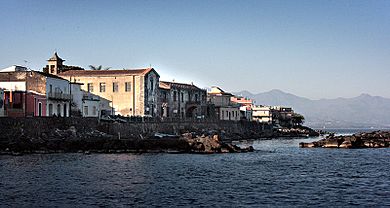Palazzo Vigo facts for kids
Palazzo Vigo is a beautiful old building in a small Italian village called Torre Archirafi. This village is located on the sunny island of Sicily. The palace was once known as Palazzo Natoli, or the "Palace of the Princes Natoli." Today, it is owned by the local government of Riposto and is a busy place for art exhibitions, meetings, and talks.
Contents
What is Palazzo Vigo?
Palazzo Vigo is a historic palace found in Torre Archirafi, a charming village. This village is part of the larger town of Riposto, which is located in the Province of Catania on the eastern coast of Sicily. The palace stands as a reminder of the past, showing how important families lived centuries ago.
Who Built This Palace?
The palace was built a long time ago, in the 18th century. A powerful man named Giovanni Natoli Ruffo started its construction. He was known as the Prince of Sperlinga, which was a very important title back then. In 1741, King Charles V of Sicily gave him another special title: Duke of Archirafi. This shows how much influence Giovanni Natoli Ruffo had.
A Chapel for the Family
Just a couple of years after starting the palace, in 1743, Giovanni Natoli Ruffo also built a small chapel right next to it. This private chapel was likely used by his family for prayers and religious services. It was common for wealthy families to have their own chapels close to their homes.
How Did the Palace Change Hands?
Over the years, the ownership of Palazzo Vigo changed. By the year 1900, the palace and all the land around it belonged to another important family, the Vigo di Gallodoro family. This is how the palace got its current name, Palazzo Vigo.
What is the Palace Used For Today?
Today, Palazzo Vigo is no longer a private home. The local government, known as the Comune of Riposto, now owns it. They use this grand old building for many public events. It hosts art exhibitions where people can see beautiful artworks. It's also a place for conferences and lectures, bringing people together to learn and share ideas.


